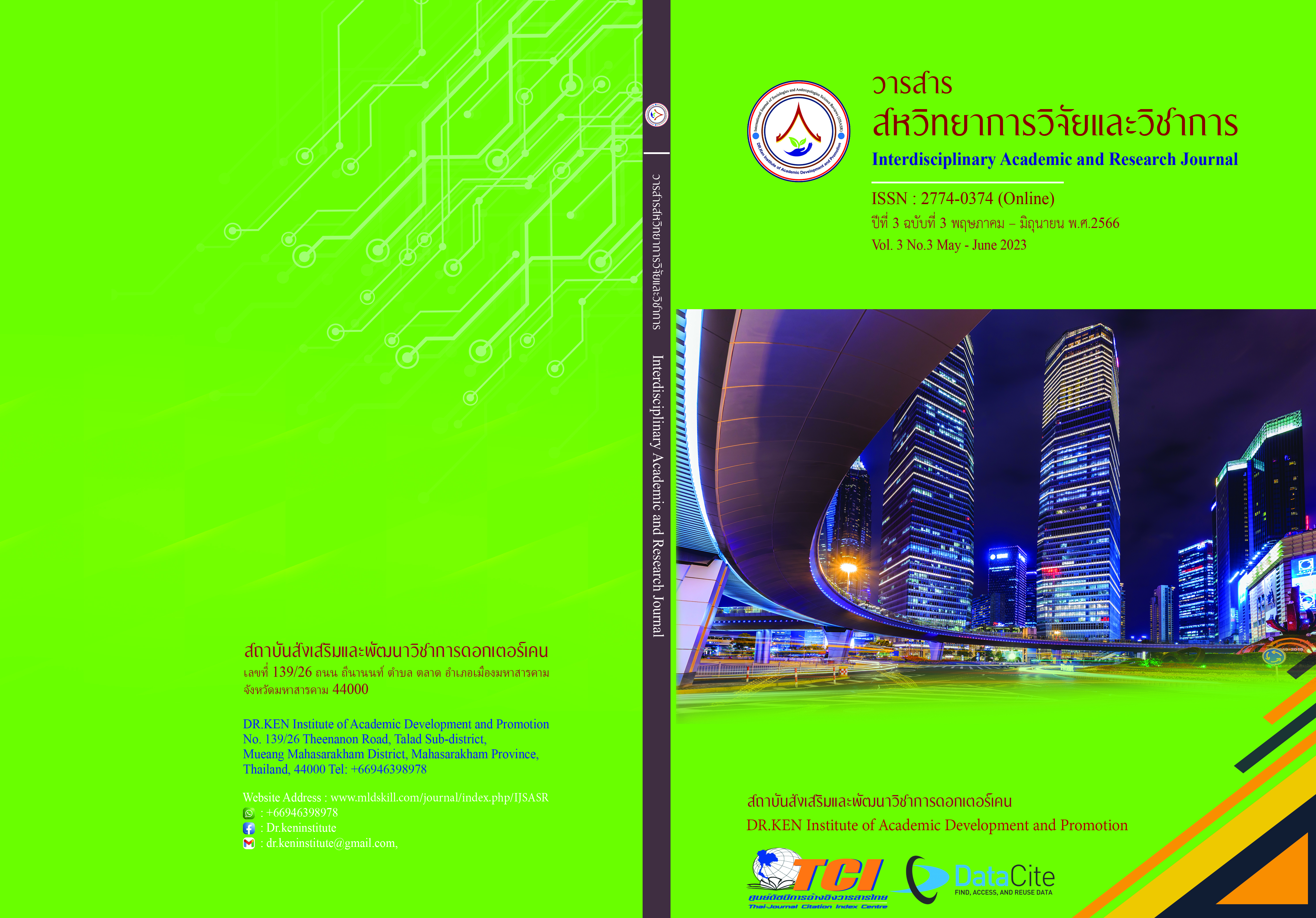Construction of Mixed-Format Tests in Mathematics Online Testing on Fractions for Grade 6 Students: an Application of One-Parameter Item Response Theory
DOI:
https://doi.org/10.14456/iarj.2023.159Keywords:
Mixed-format Tests; , Online Testing; x, Online Testing; Item Response TheoryAbstract
The study of online testing in past research has primarily focused on addressing issues related to academic dishonesty, utilizing multiple-choice questions to improve the efficiency of measuring and evaluating student performance. Combining subjective and multiple-choice questions offers an alternative approach to achieving a more comprehensive evaluation of learning outcomes. Consequently, the objectives of this study were 1) to develop mixed-format online mathematics tests on fractions for Grade 6 students, and 2) to investigate the psychometric properties of these mixed-format online mathematics tests using one-parameter item response theory. The population of this study was 104 Grade 6 students from five schools in the 2022 academic year under the Bang Rak District Office. The research instrument used consisted of the mixed-format online mathematics tests on fractions, which were divided into three tests with different content. The data were analyzed by examining the psychological properties of the test, including content validity, reliability, difficulty (b), item information function (IIF), and test information function (TIF). The results showed that: (1) The mixed-format tests in online mathematics testing on fractions had a ratio of the number of multiple-choice questions: subjective questions of 30:70 (9 multiple-choice questions and 21 subjective questions). There were three tests with 30 items divided among different contents. All three developed tests had difficulty (p) and discrimination (r) that met all criteria. (2) The values of content validity were 0.67 or higher, and those of reliability were 0.912, 0.915, and 0.913, respectively. The results of difficulty (b) ranged from -0.56 to +0.93. Also, the item information function and test information function of the three tests mostly provided a high level of information when tested on individuals with moderate to high ability.
References
ชัชสันต์ จันทร์เรืองฤทธิ์. (2559). ระบบประเมินความรู้ผ่านเครือข่าย (e-Testing): กรณีศึกษาคลังข้อสอบสนันสนุนการสอบใบประกอบวิชาชีพวิศวกรรมควบคุม. วิทยานิพนธ์ปริญญามหาบัณฑิต: มหาวิทยาลัยวลัยลักษณ์.
เตือนใจ เกตุษา และสุรศักดิ์ อมรรัตนศักดิ์. (2551). การประเมินผลการศึกษา. มหาวิทยาลัยรามคำแหง.
ทรรศนันทน์ ภักดิ์ภูมิสิริ. (2559). ระบบการเตรียมความพร้อมและแบบทดสอบออนไลน์สำหรับการสอบตำแหน่งครูผู้ช่วย. วิทยานิพนธ์ปริญญามหาบัณฑิต: มหาวิทยาลัยอุบลราชธานี.
พนิดา พานิชวัฒนะ. (2560). การเปรียบเทียบประสิทธิภาพของกระบวนการปรับเทียบคะแนนสังเกตได้ตามทฤษฎีการตอบสนองข้อสอบแบบพหุมิติ สำหรับแบบสอบรูปแบบผสม ภายใต้ผู้สอบกลุ่มไม่เท่าเทียมกันโดยใช้ข้อสอบร่วม. วิทยานิพนธ์ปริญญาดุษฎีบัณฑิต: จุฬาลงกรณ์มหาวิทยาลัย.
พระครูใบฎีกาศรีธนญชัย ธนญฺชยเมธี. (2561). การพัฒนาระบบทดสอบออนไลน์เพื่อการศึกษาของมหาวิทยาลัยมหาจุฬาลงกรณราชวิทยาลัย. วิทยานิพนธ์ปริญญามหาบัณฑิต: มหาวิทยาลัยมหาจุฬาลงกรณราชวิทยาลัย.
พิมพิศา สว่างศรี. (2558). การเปรียบเทียบคุณสมบัติทางจิตมิติของแบบสอบที่บูรณา การระหว่างตัวชี้วัดความสามารถในการอ่านคิดวิเคราะห์ และเขียน กับตัวชี้วัดสาระการเรียนรู้วิทยาศาสตร์ชั้นมัธยมศึกษาปีที่ 3 ที่มีวิธีการทบทวนข้อสอบที่แตกต่างกัน. วิทยานิพนธ์ปริญญามหาบัณฑิต:จุฬาลงกรณ์มหาวิทยาลัย.
สำนักงานเขตบางรัก. (2565). รายงานสถิติการศึกษา ฝ่ายการศึกษา สำนักงานเขตบางรัก. กรุงเทพฯ: สำนักงานเขตบางรัก.
รุ่งนภา แสนอำนวยผล. (2555). ประสิทธิภาพของแบบวัดผลสัมฤทธิ์ทางการเรียนรูปแบบผสม: การประยุกต์ใช้ทฤษฎีการตอบสนองข้อสอบแบบตรวจให้คะแนนความรู้บางส่วนและทฤษฎีการตอบสนองข้อสอบแบบตรวจให้คะแนนความรู้บางส่วนแบบทั่วไป. วารสารศึกษาศาสตร์, 35(1), 58-66.
วีระศักดิ์ วีระวงศ์. (2554). การบริหารระบบการจัดการการสอบออนไลน์คณะวิศวกรรมศาสตร์ มหาวิทยาลัยแห่งชาติลาว. วิทยานิพนธ์ปริญญาดุษฎีบัณฑิต: มหาวิทยาลัยเทคโนโลยีพระจอมเกล้าธนบุรี.
ศิริชัย กาญจนวาสี. (2535). ทฤษฎีการวัดและประเมิน (Theories of measurement and evaluation).สำนักพิมพ์แห่งจุฬาลงกรณ์มหาวิทยาลัย.
ศิริชัย กาญจนวาสี. (2555). ทฤษฎีการสอบแนวใหม่. พิมพ์ครั้งที่ 4. สำนักพิมพ์แห่งจุฬาลงกรณ์มหาวิทยาลัย.
ศิริชัย กาญจนวาสี. (2556). ทฤษฎีการทดสอบแบบดั้งเดิม. พิมพ์ครั้งที่ 7. สำนักพิมพ์แห่งจุฬาลงกรณ์มหาวิทยาลัย.
ศิวะทัศน์ สุขสุวรรณ. พัชรี จันทร์เพ็ง และสังวร งัดกระโทก (2555). คุณภาพของการเชื่อมโยงคะแนนแนวตั้งแบบพหุมิติ สำหรับแบบสอบรูปผสมด้วยวิธีโค้งลักษณะแบบสอบ. วารสารศึกษาศาสตร์, 32(2), 109-118.
ศุภกฤษฎิ์ ตั้งเสริมสิทธิ์. (2556). การออกแบบและพัฒนาระบบสอบออนไลน์เคลื่อนที่จาก มทส. ให้รองรับรูปแบบข้อสอบตามมาตรฐาน สทศ. วิทยานิพนธ์ปริญญามหาบัณฑิต: มหาวิทยาลัยเทคโนโลยีสุรนารี.
ศุภลักษณ์ จุเครือ (2559). การสร้างแบบทดสอบออนไลน์ (e-Testing). Multimedia e-News. 37 (4), https://muit.mahidol.ac.th/enews/multimedia/download/201611.pdf
สมนึก ภัททิยธนี. (2556). การวัดผลการศึกษา (พิมพ์ครั้งที่ 9). ประสานการพิมพ์.
สัตยา นาอุดม. (2559). การพัฒนาแบบทดสอบการรู้เรื่องคณิตศาสตร์ โดยประยุกต์ใช้โมเดลการตอบสนองข้อสอบแบบพหุมิติ. วิทยานิพนธ์ปริญญามหาบัณฑิต: มหาวิทยาลัยราชภัฏมหาสารคาม.
อนุพงษ์ กันธิวงค์. (2560). การเปรียบเทียบดัชนีความเป็นคู่ขนานของข้อสอบและแบบสอบที่ได้จากการคัดเลือกข้อสอบโดยกลุ่มผู้เชี่ยวชาญที่มีลักษณะแตกต่าง: การประยุกต์ใช้ทฤษฎีฉันทามติทางวัฒนาธรรมแบบมีรูปแบบ. วิทยานิพนธ์ปริญญามหาบัณฑิต: จุฬาลงกรณ์มหาวิทยาลัย.
อภิชาติ รอดนิยม. (2563). เทคโนโลยีการศึกษากับการจัดการเรียนการสอนออนไลน์ในยุคใหม่. Journal of Social Science and Buddhistic Anthropology. 6 (9), 123-133.
อัญชลี ศรีกลชาญ. (2552). คุณภาพของการปรับเทียบคะแนนสำหรับแบบสอบรูปแบบผสม: การประยุกต์ใช้การปรับเทียบตามทฤษฎีการตอบสนองข้อสอบด้วยวิธีโค้งคุณลักษณะและการปรับค่าพารามิเตอร์พร้อมกัน. วิทยานิพนธ์ปริญญาดุษฎีบัณฑิต: จุฬาลงกรณ์มหาวิทยาลัย.
อินทิรา ธ.น.ก่ำ. (2561). การพัฒนาระบบคลังข้อสอบออนไลน์ วิชาวิทยาศาสตร์ เรื่อง สิ่งมีชีวิตกับกระบวนการดำรงชีวิต ระดับชั้นประถมศึกษาปีที่ 6. วิทยานิพนธ์ปริญญามหาบัณฑิต: มหาวิทยาลัยราชภัฏมหาสารคาม.
Ali, U.S., & Rijn, P.W. (2016). An evaluation of different statistical targets for assembling parallel form in item response theory. Applied psychological measurement, 40(3), 163-179.
Cao, Y. (2008). Mixed format test equating: Effects of test dimensionality and common item sets. [Unpublished doctoral dissertation]. University of Maryland.
Hambleton, R. K., & Kanjee, A. (1995). Increasing the validity of cross-cultural assessments: Use of improved methods for test adaptations. European Journal of Psychological Assessment, 11(3), 147–157. https://doi.org/10.1027/1015-5759.11.3.147
Lin, M. J. (2011). The Design and Development of a Context-Rich, Photo-Based Online Testing to Assess Students’ Science Learning, US-China Education Review.
Pennebaker J.W., Gosling S.D., & Ferrell J.D. (2013). Daily Online Testing in Large Classes: Boosting College Performance while Reducing Achievement Gaps. PLoS ONE, 8(11), e79774. doi:10.1371/journal.pone.0079774.
Downloads
Published
How to Cite
Issue
Section
License
Copyright (c) 2023 กนกพร จันทร์สีหราช, จุฑาภรณ์ มาสันเทียะ, ดารุณี ทิพยกุลไพโรจน์

This work is licensed under a Creative Commons Attribution-NonCommercial-NoDerivatives 4.0 International License.
Copyright on any article in the Interdisciplinary Academic and Research Journal is retained by the author(s) under the under the Creative Commons Attribution-NonCommercial-NoDerivatives 4.0 International License. Permission to use text, content, images, etc. of publication. Any user to read, download, copy, distribute, print, search, or link to the full texts of articles, crawl them for indexing, pass them as data to software, or use them for any other lawful purpose. But do not use it for commercial use or with the intent to benefit any business.
















.png)


